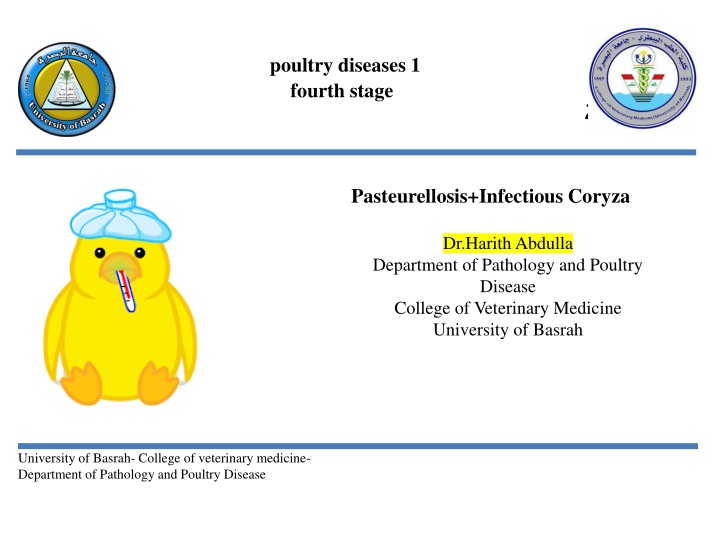
Pasteurellosis and Fowl Cholera in Poultry Diseases
"Learn about Pasteurellosis and Fowl Cholera, two significant diseases affecting poultry caused by Pasteurella multocida. Explore their symptoms, post-mortem lesions, chronic types, and laboratory diagnosis methods."
Download Presentation

Please find below an Image/Link to download the presentation.
The content on the website is provided AS IS for your information and personal use only. It may not be sold, licensed, or shared on other websites without obtaining consent from the author. If you encounter any issues during the download, it is possible that the publisher has removed the file from their server.
You are allowed to download the files provided on this website for personal or commercial use, subject to the condition that they are used lawfully. All files are the property of their respective owners.
The content on the website is provided AS IS for your information and personal use only. It may not be sold, licensed, or shared on other websites without obtaining consent from the author.
E N D
Presentation Transcript
poultry diseases 1 fourth stage Pasteurellosis+Infectious Coryza Dr.HarithAbdulla Department of Pathology and Poultry Disease College of Veterinary Medicine University of Basrah University of Basrah- College of veterinary medicine- Department of Pathology and Poultry Disease
Pasteurellosis Fowl Cholera Definition: Fowl cholera is acute septicemic disease of domestic fowl and wild birds caused by Pasteurella multocida, (Pasteurella aviseptica) characterized by high morbidity and mortality. Synonyms: 1-Avian Cholera. 2-Avian Pasteurellosis. 3-Avian Hemorrhagic Septicemia.
Susceptibility: Chickens, turkeys and ducks are most commonly affected. Epizootiology: 1-Healthy nasal carriers provide a source of infection. 2-The natural spread of the disease is by ingestion and inhalation. 3-Mechanical transmission by vectors.
Symptoms: 1- Age: Semimature to mature. 2- Acute: a-Sudden death of well fleshed birds. b-Greenish and yellowish diarrhea. c- Mucous in mouth and nostrils. d- Cyanotic comb and wattles. 3-Chronic: a-Carriers due to localization of the bacteria. b-Swollen wattles and eyes. c- Inflammation of joints and tendon sheath of legs and wings. d- Torticollis.
Post-mortem lesions: Acute: a- A sticky mucous in the mouth and nasal passages. b- Generalized congestion. C- Hemorrhage in the heart muscles particularly around the coronary groove and gizzard. d- Pericardial sac contains an excess of yellowish fluid . e- Liver: very dark or lighter than usual, with many white necrotic foci. f-Inflammation and hemorrhage in the duodenum. g- Lung: Consolidation and congestion with small hemorrhage . h- Cheesy , yellowish deposits in various parts of the body, especially on the air sacs and intestine.
Chronic type: a-Dried cheesy, yellow material is found free in the abdominal cavity or adhere to some organ due to ruptured yolk. b-Hemorrhage of the ovary . Ova: Soft, flabby, irregular in outline and pedunculated . Greenish colored ovum is observed.(Due to salpingitis). C- Caseous swollen wattles and joints. d- Suppurative meningitis due to the localization of bacteria at the base of skull, ear and brain.
Histopathology: 1-Coagulation necrosis. 2-Heterophilic infiltration. Diagnosis: 1-History. 2-Signs. 3-Lesions. 4-Laboratory diagnosis. a-Finding of bipolar bacteria. b- Isolation and characterization of bacteria from circulatory blood, liver and other organs. c- Agglutination test. d- Laboratory animal inoculation ( chick and mice).
Control: 1-Water sanitation. 2- Good management. 3-Control flies and rodents. 4-Vaccination at 12-16 weeks and repeat 4-8 weeks later. Treatment: 1-Sulfanomides. 2-Terramycin in water or feed.
Field Differential Diagnosis: Pullorum Fowl Typhoid Fowl Cholera Comb and wattles Pale Pale Cyanotic Joints Normal Normal Swollen Liver size Enlarged 2-3 Enlarged 2-3 Normal to slightly enlarged Liver color Red Bronzy Red Necrotic foci in the liver + + ++ Spleen size Enlarged 2-3 Enlarged 2-3 Normal Heart Nodules Nodules Hemorrhagic Ceca Core Core Inflammation and hemorrhage
Infectious Coryza Definition: Acute severe catarrhal inflammation of the mucous membranes of the upper respiratory tract. Chronic form also found. Synonyms:Coryza , Roup , Cold . Etiology: Hemophilus paragallinarum
Susceptibility:Chickens only Chickens( 14 ) weeks of age and older are most susceptible. Epizootiology: 1- Transmission through carrier. 2- Contact. 3- Contaminated water and feed.
Symptoms: Acute 1-Rapid onset and rapid spread. 2-Thin watery discharge from nostrils becomes thick and sticky, with an offensive odor. The discharge becomes drying yellowish crusts around the nasal openings. 3-Sinuses filled with mucous, the mucous becomes dry cheesy causes bulging about the eye(Ocular Roup). 4- Rattling noises. 5- Sneezing, coughing and swollen face and wattles. 6-Affected birds shake their heads to get rid of mucous.
Post mortem lesions: Acute: 1-Acute catarrhal inflammation of mucous membranes of the nasal passages and sinuses. 2- Catarrhal conjunctivitis. 3-Subcutaneous edema of the face and wattles. Chronic: Caseous exudates in the sinuses, nasal passages and conjunctival sacs.
Histopathology: 1-Sloughing and hyperplasia of the mucosal and glandular membrane. 2-Heterophilic infiltration of upper respiratory tract. Diagnosis: 1-History. 2-Symptoms: Particularly bad odor of exudates.
Differential Diagnosis: 1-Fowl Pox : Yellowish patches in the throat : Are easily removed in Roup , while in Pox they are adhered to the lower layer. 2-Chronic Fowl Cholera. 3-Vitamin A Deficiency . 4-CRD. Treatment: Sulfathiazole.
